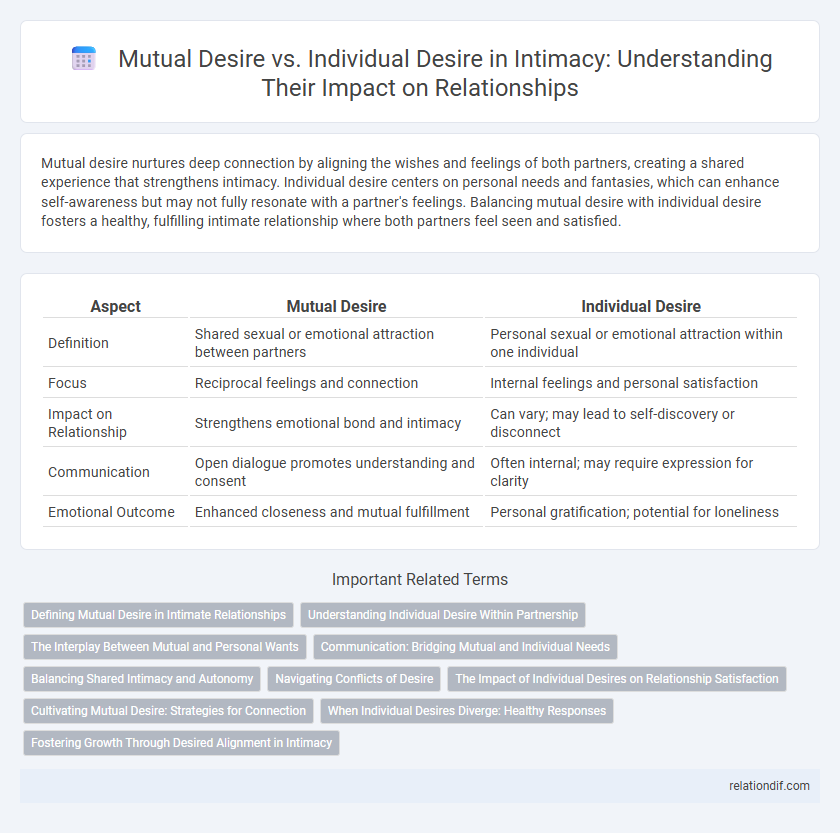Mutual desire nurtures deep connection by aligning the wishes and feelings of both partners, creating a shared experience that strengthens intimacy. Individual desire centers on personal needs and fantasies, which can enhance self-awareness but may not fully resonate with a partner's feelings. Balancing mutual desire with individual desire fosters a healthy, fulfilling intimate relationship where both partners feel seen and satisfied.
Table of Comparison
| Aspect | Mutual Desire | Individual Desire |
|---|---|---|
| Definition | Shared sexual or emotional attraction between partners | Personal sexual or emotional attraction within one individual |
| Focus | Reciprocal feelings and connection | Internal feelings and personal satisfaction |
| Impact on Relationship | Strengthens emotional bond and intimacy | Can vary; may lead to self-discovery or disconnect |
| Communication | Open dialogue promotes understanding and consent | Often internal; may require expression for clarity |
| Emotional Outcome | Enhanced closeness and mutual fulfillment | Personal gratification; potential for loneliness |
Defining Mutual Desire in Intimate Relationships
Mutual desire in intimate relationships refers to the shared longing and attraction between partners, where both individuals actively seek and enjoy closeness and connection. This reciprocal attraction fosters emotional safety, trust, and deeper bonding, distinguishing it from individual desire, which may be one-sided or unreciprocated. Understanding mutual desire is essential for sustaining intimacy and ensuring that both partners' needs and boundaries are honored, leading to a balanced and satisfying relationship dynamic.
Understanding Individual Desire Within Partnership
Understanding individual desire within a partnership involves recognizing each partner's unique needs, preferences, and boundaries while maintaining emotional connection. Mutual desire strengthens intimacy by fostering open communication and empathy, allowing partners to navigate differences without judgment. Prioritizing individual desire supports personal well-being and contributes to a balanced, fulfilling relationship.
The Interplay Between Mutual and Personal Wants
Mutual desire in intimacy fosters deeper connection by aligning partners' emotional and physical wants, creating a shared sense of fulfillment. Individual desire reflects personal needs and boundaries that influence relationship dynamics and self-expression. The interplay between mutual and personal wants requires ongoing communication and empathy to balance intimacy with personal autonomy.
Communication: Bridging Mutual and Individual Needs
Effective communication plays a crucial role in bridging mutual and individual desires within intimacy, fostering understanding and alignment between partners. Expressing personal needs clearly while actively listening to a partner's perspective helps create a balanced dynamic where both parties feel valued and fulfilled. This open dialogue strengthens emotional connection, enhancing satisfaction and trust in the relationship.
Balancing Shared Intimacy and Autonomy
Balancing shared intimacy and autonomy requires recognizing that mutual desire strengthens emotional bonds while individual desire nurtures personal growth. Prioritizing open communication helps partners align their needs without sacrificing independence. This equilibrium fosters a resilient relationship where connection and self-expression coexist harmoniously.
Navigating Conflicts of Desire
Navigating conflicts of desire in intimacy requires open communication to balance mutual desire and individual needs, preventing misunderstandings and resentment. Recognizing personal boundaries while honoring your partner's feelings fosters a healthy dynamic where both partners feel valued. Effective negotiation and empathy are key to aligning desires and enhancing emotional connection.
The Impact of Individual Desires on Relationship Satisfaction
Individual desires significantly influence relationship satisfaction by shaping personal fulfillment and emotional connection within the partnership. When personal needs diverge from mutual desires, conflicts or feelings of neglect may arise, reducing intimacy and satisfaction. Prioritizing open communication and negotiation helps align individual desires with shared goals, fostering deeper intimacy and relationship stability.
Cultivating Mutual Desire: Strategies for Connection
Cultivating mutual desire requires active communication and emotional attunement, fostering a safe space where partners can express needs and boundaries openly. Engaging in shared activities and prioritizing quality time strengthens the emotional bond, reinforcing the connection beyond individual impulses. Mindfulness and empathy promote understanding, allowing both partners to co-create a fulfilling intimate experience grounded in mutual respect and harmony.
When Individual Desires Diverge: Healthy Responses
When individual desires diverge in intimacy, prioritizing open communication helps partners express needs without judgment. Establishing boundaries and practicing empathy fosters mutual respect and prevents resentment. Seeking compromise or professional guidance supports maintaining connection despite differing personal desires.
Fostering Growth Through Desired Alignment in Intimacy
Mutual desire serves as the foundation for fostering growth through aligned intimacy, where both partners actively nurture shared emotional and physical connection. Prioritizing communication and empathy strengthens the bond, allowing individual desires to harmonize with the collective experience. This alignment promotes deeper trust, vulnerability, and sustained relational satisfaction.
Mutual desire vs individual desire Infographic

 relationdif.com
relationdif.com